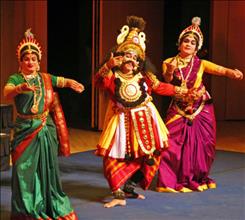Historical evidences reveal that the earliest celebrations that the semi-civilised man organised were held around light and fire, maybe for protection against wild animals that the fire frightened, and the light alerted against emergent dangers. Out of this cult people, perhaps those from early civilisations developed their own festivals of light, independent ones discovering the glory of light, as the Indian Festival of Deepawali; or those associated with some religious events such as Christmas and the New Year in the Christian world; or the Shab-i-Barat, in Islam.
Whatever the theological contexts attached, the primary thrust of these festivals, in whichever degree, is the victory of light over darkness.
Unknown origin
 The origin of the Festival of Deepawali, or Diwali, when or how it was begun or who initiated it, is not known.
The origin of the Festival of Deepawali, or Diwali, when or how it was begun or who initiated it, is not known.
The Bhandarkar Oriental Research Institute, Pune, has made brilliant efforts in its volume XXVI to trace the origin of Deepawali celebrations but even such efforts could take back its origin only up to the beginning of the Christian era, not beyond.
The Hindu tradition relates Deepawali celebrations with the event of Rama’s return to Ayodhya after his victory over Ravana but the Ramayana does not allude to any such celebrations. Massive arrangements were made to welcome Rama at Nandigram and every inch of land between Nandigram and Ayodhya was levelled, sprinkled and beautified. Flags were posted on every house and all inhabitants of Ayodhya were out on streets to welcome Rama with folded hands.
But these took place in the early part of the day.
In this sub-canto, perhaps only once allusion to lamps or light is made. As commanded by Shatrughna, servants of the state rushed with oil lamps, beds and cushions to the palace where Sugriva stayed. It seems that by the time of Valmiki auspices were carried out only during the day and there was not perhaps the tradition of holding corresponding celebrations during the night.
 Yaksha Night
Yaksha Night
The so far known earliest text that alludes to celebrating a night with multitudinous lights – a kind of the festival of light, is the Kama Sutra by sage Vatsyayana, datable to around the third Century BC to the first or second century AD.
Most significant among the nights that Vatsyayana recommends to celebrate is the night of ‘Yakshas’ or the Yaksha Night.
He ordains that on the Yaksha night, houses should be illuminated with the light of tiny earthen lamps placed in rows close to each wall and window ledges, and the gardens should have bonfires.
Yakshas were celestial beings fundamentally inclining to enjoyment. Thus, the Yaksha Night was the Festival of light and merriment.
At another place in the text, Vatsyayana recommends gambling as the sport for the occasion. Thus, Vatsyayana’s Yaksha Night was celebrated with light, merriment and gambling, something that continues as part of Deepawali.
The term ‘Deepawali’ comprises two syllables, namely ‘Dipa’ and ‘Awali’, one meaning ‘lamp’ and other, ‘row’, that is, row of lamps, exactly with what Vatsyayana ordains Deepawali celebrations.
Editor’s Note: A similar reference is made by the Hindu Council of New Zealand in the article, ‘Indifference to customs negates the festive spirit’ appearing elsewhere in this Diwali 2014 Special.
In their commentaries on the Kama Sutra, Jain Zacharias Hem Chandra and Yashodhara have also identified the Festival of Yaksha Night as an early form of Deepawali.
‘Kalaratri’ (The Deadly Night), ‘Maha Ratri’ (The Impenetrable Night), ‘Muhka Ratri’ (The Night of Initiation) belong to the ‘Yaksha Ratri’ Category.
These were names used in the Puranas to address Deepawali.
Varying Festivals
In his play ‘Nava Nand,’ King Harsh, who had a long tenure (606 AD to 648 AD), talks of ‘Dipotsava,’ meaning the Festival of Lamps, similar to Deepawali.
Nilamata Purana of the Kashmiri origin, composed between 500 AD and 800 AD, gives an elaborate account of the Dipa Mala Festival.
All round illuminations, decorations, especially by hoisting up festoons, feasting Brahmins and relatives, gambling, music, passing nights in company of ladies, wearing rich apparel and jewels and making presents of new garments to friends, relatives, Brahmins and household were some essential features of Deepawali celebrations.
In his ‘Yashastilakachampoo’ (959 AD), Someshvarasuri makes a special mention of decorating houses on Deepawali. According to him, the houses were whitewashed and their tops were decorated with rows of bright lights.
Travellers’ accounts
In his Tahkik-i-Hind, well-known traveller Abu Rayhan Al Biruni, who was in India in 1030 AD, gives an identical account of Deepawali celebrations.
He talks of people visiting temples, giving alms, exchanging betel leaves and areca nuts. He also mentions of gambling and a few Deepawali-related legends.
He says that it was considered as the day for trying one’s luck, and it was on this day that Goddess Lakshmi was liberated from Bali’s clutches.
In his memoirs, Italian traveller Nicoloi Conti gives an elaborate picture of how Indians celebrated Deepawali. In about 1420-21, he was in Vijayanagara and that lamps were lit day and night in temples and on house tops the whole night.
In his Ain-i-Akbari, Abul Fazal circumscribes Deepawali as the Festival of Vaisyas, the trading community, but such was its popularity and attraction that Akbar himself participated in its celebrations.






